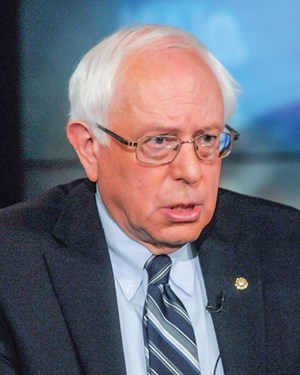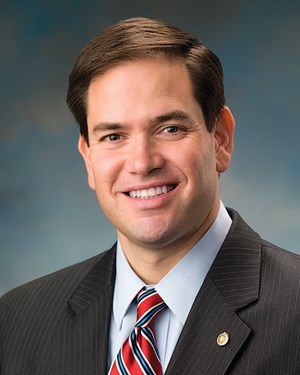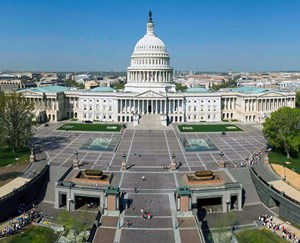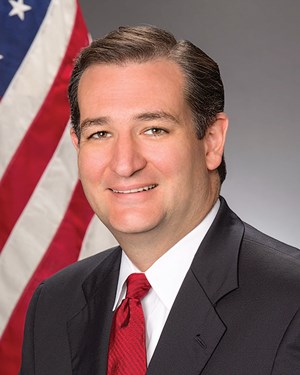An eventful year is ahead for oil and gas

On Nov. 8, 2016, the U.S. national elections will be held, and there is much at stake for the oil and gas (O&G) industry. Aside from the presidential vote, 469 seats in the U.S. Congress (34 Senate seats and all 435 House seats) are in play.
CONGRESSIONAL RACES
The major uncertainty of the congressional elections is whether or not the Democrats will regain control of the Senate. Control of the House in 2016 is unlikely to be in question, since the Democrats need a net 30-seat gain, a nearly impossible task. Nevertheless, Democrats still hope to reduce the Republican majority—Republicans have their largest House majority since 1928.
The Senate has 54 Republicans and 44 Democrats. Two independents caucus with the Democrats, which effectively gives them control of 46 seats. To control the Senate, Democrats need to gain four or five seats in 2016 (depending on the outcome of the presidential race, since the Vice President breaks tie votes in the Senate). This will be difficult, but not impossible. Democrats have their best chances to gain Senate seats in Illinois, Wisconsin, Florida, Pennsylvania, New Hampshire and (perhaps) Ohio.
Democrats have three advantages in the senatorial elections this year. First, they have only 10 seats to defend, while the Republicans have 24. The majority of vulnerable seats are held by Republican incumbents. Second, 2016 is a presidential election year, and this usually works to Democrats’ advantage. Presidential elections generate high voter turnout, especially among Democratic constituencies. Finally, as discussed below, Donald Trump’s emergence in the Republican nomination battle has thrown the party into chaos and alienated key constituencies.
PRESIDENTIAL CANDIDATES’ ENERGY PLANS
The two Democratic candidates are former First Lady, New York Senator, and Secretary of State Hillary Clinton and Vermont “Democratic Socialist” Sen. Bernie Sanders, with Ms. Clinton the overwhelming favorite. Both candidates favor energy and environmental policies that are anathemas to the O&G industry. For example, they:
- Favor aggressive global warming policies and regulations
- Support rapidly phasing out fossil fuels
- Support the recent Paris climate agreement (PCA)
- Endorse increased tax incentives and mandates for renewable energy (RE)
- Oppose offshore and Arctic drilling
- Support EPA’s Clean Power Plan (CPP)
- Endorse increased EPA regulation of O&G
- Support carbon regulations and taxes
- Oppose nuclear power
- Support banning crude oil exports
- Oppose the Keystone pipeline
- Favor increased pipeline and rail regulations
- Oppose tax incentives and support for O&G.

As President, Clinton would negotiate a “North American Climate Compact” between the U.S., Canada and Mexico, to create national mandates for emission reductions in each country. She also would develop common infrastructure standards, expand regional emission trading markets, invest in low-carbon transportation, and set methane reduction standards. Her detailed plan recommends, among other things, installation of 500 million solar panels by 2021, a 700% increase over the current number.
Clinton’s distasteful policies are almost “moderate,” compared to those of the other candidate. Sanders has labeled climate change “the greatest threat facing our planet.” He advocates reducing carbon emissions 40% by 2030, and 80% by 2050. This is significantly more than the up-to-28% reduction by 2025 that Obama pledged at the Paris climate conference. Sanders would impose a carbon tax; ban all offshore drilling and fossil-fuel leases on federal lands; stop “dirty pipeline” projects; ban O&G exports; prohibit fracing; impose a 65-mpg standard by 2025; enact “massive” federal subsidies for RE and energy efficiency; federally underwrite electric-car charging stations, high-speed rail, and smart grids; eliminate nuclear power; and provide “clean energy funding” to the world. Sanders contends that “decarbonization” will require a “government-mandated remake of the U.S. economy.” It also may require a remake of American society.
The only Democratic candidate who made any sense on energy was ex-Sen. Jim Webb of Virginia, and he dropped out of the race. However, he is considering running as an independent. In the election, this could shift Virginia into the Republican column in the Electoral College, which could be significant in a close presidential race.
The top three Republican candidates are billionaire businessman Donald Trump, Texas Sen. Ted Cruz, and Florida Sen. Marco Rubio. The energy and environmental policies of these three candidates—and other Republican hopefuls—are virtual opposites of Democratic attitudes. For example, the Republicans would:
- Prevent federal regulation of fracing
- Rewrite Obama’s five-year offshore drilling plan
- Approve the Keystone XL pipeline and remove barriers for additional pipelines
- Support the end of the ban on crude oil exports
- Expedite approval of U.S. gas exports
- Oppose international climate negotiations
- Expose the true costs of environmental litigation, and limit regulators’ power
- Reverse Obama’s carbon mandates
- Simplify environmental review processes
- Facilitate private-sector new technology development
- Reduce business taxes
- Repeal the renewable fuels standard
- Streamline processes for upgrading existing refineries and building new ones
- Force Congress to vote on EPA regulations
- Increase energy development on federal lands
- Expand offshore exploration and development
- Increase U.S. energy exports.
Trump refers to oil as the “lifeblood” of the nation and job market; supports fracing to end dependence on imported oil; and favors the Keystone pipeline. He would strengthen the U.S. energy infrastructure, stating that “I know how to build, politicians only know how to talk!”
Cruz also will eliminate burdensome, unnecessary Obama regulations and promote American energy independence. He will unleash American jobs and opportunities by harnessing U.S energy resources; stopping harmful regulations; and eliminating barriers to trade and infrastructure development. He will return power to the states and private sector, freeing American energy innovators from damaging federal regulations. He will remove barriers that hinder development of pipelines and cross-border energy infrastructure. He will allow states to control energy development on federal lands; widen offshore exploration; and increase energy exports. Cruz will withdraw the U.S. from the PCA.
Rubio states that “America is blessed with abundant energy resources. Thanks to new technology and innovation, we are poised to become the world’s energy superpower, even as our emissions have been declining. If we harness our energy potential in the right way, and let innovation flourish, we will ensure that energy is affordable for consumers and families; help businesses grow and create jobs; protect our environment; strengthen our national security; and increase America’s influence around the world. Affordable, reliable American energy has sparked a manufacturing renaissance, enabling America’s small businesses to compete in the global economy.”
THE ELEPHANT IN THE ROOM
A specter haunts the Republicans: Donald Trump. There are three potential outcomes in the nominating process: 1) Trump could be the nominee; 2) He could lose the nomination and run as a third-party candidate; 3) He could lose the nomination and support the Republican nominee. Only the third option offers hope for Republicans to win the presidential election and retain control of the Senate.
Trump rocketed to the top of the polls after announcing his candidacy, and, defying all predictions, has remained there for eight months. If Trump is the nominee, Republicans would have to support a person that the party establishment, functionaries, and elected officials detest. Virtually all experts agree that Trump would be an electoral disaster as a presidential nominee, and for numerous down-ticket Republican candidates. (Editor’s note: The “experts” have scarcely been correct about anything in this presidential campaign cycle.) Trump has publically insulted large portions of the electorate, but he appeals strongly to a significant section of the Republican base. Yet, a Trump nomination could yield landslide defeats, similar to those of Republican Barry Goldwater in 1964 and Democrat George McGovern in 1972. Both men appealed strongly to their political bases.

As the nominee, Trump could even face a third-party challenge from Republicans, whose leaders would not want to yield the party to him. They may support an alternative candidate to maintain the party’s viability, and minimize the damage to down-ticket nominees—especially in Senate and House races—while giving faithful Republicans an alternative to Trump and (presumably) Clinton.
Second, if Trump loses the nomination, he may, despite his pledges, run as a third-party candidate. This would likely guarantee that the Democratic nominee wins the Presidency and might give Democrats control of the Senate.
The most favorable option would be for Trump to lose the nomination but support the Republican nominee. However, even Trump’s active support could be toxic to the nominee, and to Republican candidates in close races. No matter who the Republicans nominate, the election results may not be auspicious for the industry.
END OF U.S. CRUDE OIL EXPORT BAN
In December, Congress finally ended the ban on U.S. crude oil exports—a rare victory for the industry (and defeat for environmentalists) that few even thought possible. Nearly 40 years to the day after the ban was enacted, Obama signed the law lifting it. The legislation, part of a $1.15-trillion budget bill, also renewed a variety of RE and conservation programs. These were the price that had to be paid to end the oil export ban.
Ending the ban had long been a priority for the industry and its congressional supporters—including several key Democratic senators—and involved a lot of deal-making with Democratic opponents. Advocates met repeatedly with skeptical Democrats, emphasizing that oil prices had declined drastically, due to a supply glut, and that ending the ban would not increase prices. They offered Democrats an opportunity to enact environmental programs and declare victory.
For Democrats, the reasoning was straightforward: They may not soon have another chance to enact their desired environmental legislation. Republicans adhered to various Democratic wishes, such as extending RE credits, omitting measures blocking Obama’s major environmental regulations, and funding a land-and-water conservation fund. They also provided tax breaks to domestic oil refineries.
The U.S. enacted the ban on exporting domestic oil in 1975, after the 1973 Arab oil embargo. The law allowed exports in specific cases, such as shipments to Canada, and it permitted exports of refined products, such as gasoline and diesel. However, in recent years, new technologies increased U.S. oil production 90% over the past decade, and gasoline prices declined to less than $2/gal in many regions.
11 MONTHS OF OBAMA REGULATION LEFT
During 2015, the Obama administration continued to issue a plethora of damaging energy and environmental regulations and decisions, including the CPP, vetoing Keystone, and agreeing to the PCA. However, even in 2016, Obama wants to “cement his legacy.”

Required by law to release new regulatory plans twice a year, the administration has done so consistently just before major holidays, when few people pay attention. Thus, the fall 2015 regulatory agenda was released on Nov. 20, the Friday before Thanksgiving. The administration released its plans for 2,224 rules, which indicated how many more regulations Obama plans to issue before he leaves office. It demonstrates that he is determined to finalize as many rules affecting the O&G industry as possible, prior to Jan. 20, 2017.
The administration already has promulgated several major environmental regs, including the CPP, increased EPA control of waterways, fracing regulations, and stricter smog rules. The latter are some of the most expensive rules ever proposed. Even excluding the November planned items, the cost of 2015 regulations is estimated to total $183 billion, including more than $40 billion for the environment and over $30 billion for energy. The industry will bear much of this cost.
It is clear why Obama did not want these publicized. Of the 2,200+ regulations being written, 144 are deemed “economically significant,” that is, expected to cost $100 million or more, each. This is a new record, exceeding Obama’s previous high of 136 during spring 2015. The new economically significant regs include limiting energy use (and increasing the costs) of everything from furnaces and dishwashers to dehumidifiers.
Thus, with 11 months left in office, the administration wants to add even more to the industry’s already excessive burdens. Those of special concern include:
- The Bureau of Land Management (BLM) has released a proposed rule to reduce gas venting and flaring from drilling projects on public lands.
- By March, BLM will release a proposed rule that results in higher royalty and rental fees charged to produce O&G on public lands, and higher bond payments and civil penalties for violations.
- By spring, BLM will propose a rule requiring that drilling permit applications be filed electronically.
- BLM will soon release a proposed rule amending its land-use planning process.
- In early 2016, the Bureau of Safety and Environmental Enforcement (BSEE) will release its final rule governing BOP design, manufacture and repair, and other well specifications.
- In early 2016, BSEE and the Bureau of Ocean Energy Management will release a final rule governing O&G exploration in Arctic waters.
- In early 2016, the Fish and Wildlife Service, and the National Park Service, will release rules tightening oversight of O&G development under their jurisdiction.
- By August, the Office of Surface Mining Reclamation and Enforcement will finalize its stream protection rule, one of Obama’s most controversial regs.
- EPA is finalizing its regulations to reduce methane and VOCs from the O&G sector. Along with the CPP, these rules are a key part of Obama’s climate agenda.
- In August, EPA will release its final model of carbon trading schemes for complying with the CPP, which requires states to develop plans to reduce CO2 emissions from existing power plants.
- In August, EPA will issue final revisions to its “exceptional events” rule. EPA is developing a new 70-ppb standard for ground-level ozone, and will use the exceptional events rule to address high levels of background ozone.
- In August, EPA will release a final rule on its interstate ozone transport regulations.
- In June, EPA will publish a final rule on its review of the national AAQS for lead.
- EPA will soon release a proposal for cost consideration in setting mercury and air toxics standards, and release a final rule in May.
- With several major water rules finalized in 2015, in particular the Waters of the U.S. rule, EPA will soon address the next tier of issues.
- EPA will soon release proposals for updating small suburbs’ stormwater permits and set monitoring standards for as many as 30 contaminants that are not monitored by drinking water systems.
- EPA will soon issue new selenium standards for California’s San Francisco Bay and Sacramento-San Joaquin River Delta region.
- DOE is developing energy efficiency rules for numerous appliances, including AC and heat pumps, small electric motors, general service lamps, residential dishwashers, ceiling fans, chargers, and numerous others.
- DOE is writing a final rule on energy conservation standards for residential, non-weatherized gas furnaces, which is highly controversial. Obama wants to reduce CO2 by 3 billion tons by 2030, through appliance energy standards and federal buildings, but DOE has, thus far, only issued standards covering 2 billion tons.
WE WILL ALWAYS HAVE PARIS
The December Paris climate talks concluded in an orgy of publicity and self-congratulation over an agreement hailed as a landmark in the global effort to reduce GHGs. The U.S. representative, Secretary of State John Kerry, called it “a victory for the planet;” and Obama stated that it was our “best chance to save the planet.”
In reality, it may be the most worthless document since the Kellogg-Briand Pact outlawed war. This pact also was signed in Paris by all major powers (including Germany and Japan), with much publicity and enthusiasm, virtually 11 years to the day before the start of WWII. Moreover, that pact may, actually, have been counterproductive. It eliminated the legal distinction between war and peace because signatories, having renounced the use of war, began to wage wars without declaring them.
Similarly, Paris climate agreement signatories, having declared victory and with no legal obligations, can now proceed to “voluntarily” reduce GHGs and continue doing what they planned to do, anyway. They contrived “Intended Nationally Determined Contributions,” which is enviro-babel for “We invent your emissions target, whatever it is, and we will pretend to take it seriously.” India’s assurance that it will make a 30% improvement in carbon intensity is about what it is forecast to do anyway, and the country still plans to double its coal output by 2020.
The PCA sets goals for 2023, and for 2050-2100. It is an agreement about an agreement, with no legal force: Paris is an agreement not to have legally binding GHG limits. Senate Majority Leader Mitch McConnell (R-Ky.) noted that the agreement could be reversed, if Republicans win the White House this year. He noted that Obama and his international partners should remember “that this is an unattainable deal, based on a domestic energy plan that is likely illegal, that half the states have sued to halt, and that Congress has already voted to reject.”
The good news is that the Paris agreement may do minimal harm. Obama (and others) believe that making countries report their progress on reducing carbon emissions and bad-mouthing CO2 will induce massive fossil fuel reductions somewhere in the future. They naively expect that these pledges will prevail over the sheer economic interest of developing countries dependent on exploiting abundant, inexpensive, reliable oil, gas and coal. Fossil fuels are the energy source of the past, present and future, and the PCA will not change this. We should be thankful that it will not. ![]()

- Prices and governmental policies combine to stymie Canadian upstream growth (February 2024)
- U.S. producing gas wells increase despite low prices (February 2024)
- U.S. drilling: More of the same expected (February 2024)
- U.S. oil and natural gas production hits record highs (February 2024)
- U.S. upstream muddles along, with an eye toward 2024 (September 2023)
- Canada's upstream soldiers on despite governmental interference (September 2023)
- Applying ultra-deep LWD resistivity technology successfully in a SAGD operation (May 2019)
- Adoption of wireless intelligent completions advances (May 2019)
- Majors double down as takeaway crunch eases (April 2019)
- What’s new in well logging and formation evaluation (April 2019)
- Qualification of a 20,000-psi subsea BOP: A collaborative approach (February 2019)
- ConocoPhillips’ Greg Leveille sees rapid trajectory of technical advancement continuing (February 2019)





